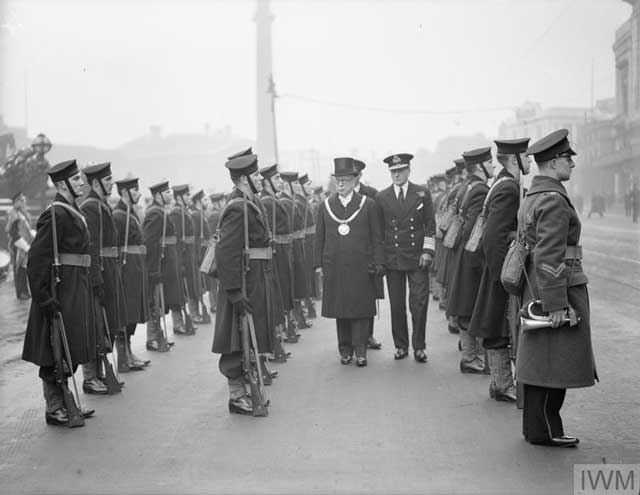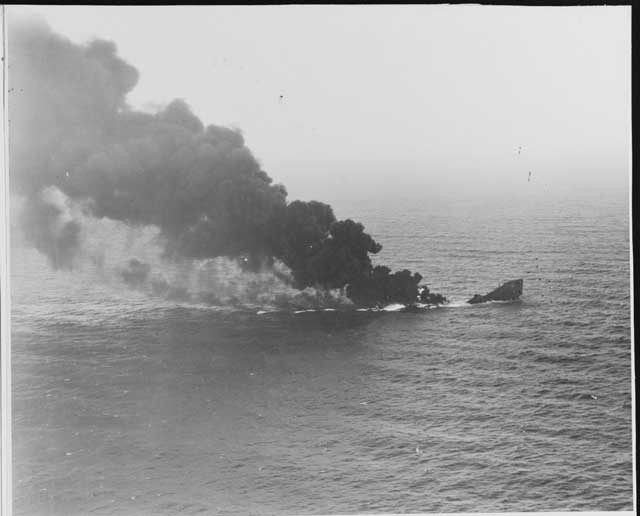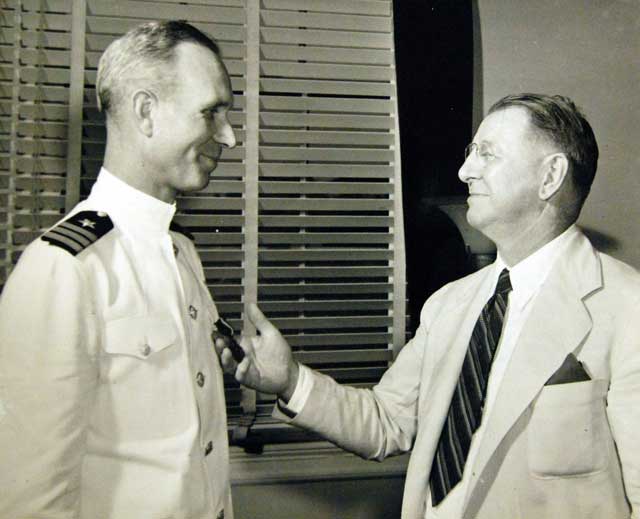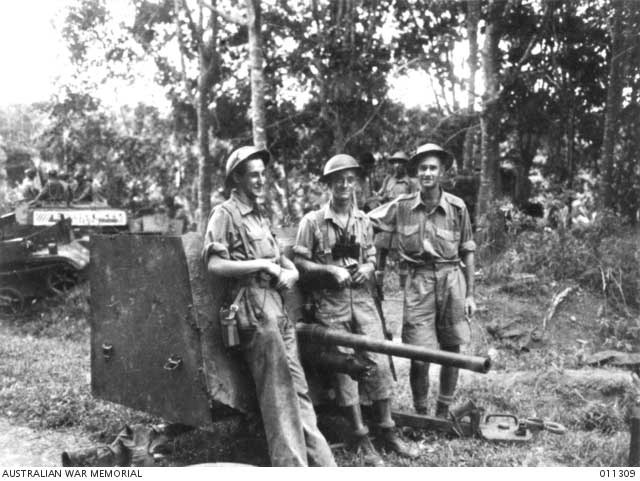Monday 19 January 1942
 |
| Latvian freighter Ciltvaira after being torpedoed by German U-boat U-123 off Cape Hatteras, NC, 19 January 1942. |
Battle of the Pacific: The battles on the Malay Peninsula in the Muar/Yong Peng area continue on
19 January 1942, but it is developing into a Japanese rout. The British order 45th Brigade and two attached Australian battalions, which together have been operating as Muar Force, to withdraw south, but this is easier said than done. Japanese planes bomb the headquarters of Indian 45th Brigade and kill its senior officers, leading to massive confusion and the brigade being taken over by an Australian officer, Lieutenant-Colonel Charles Anderson. Anderson orders the retreat, and the defeated and dispirited Commonwealth troops embark on a desperate trek south toward Johore.
 |
| "Studio portrait of NX60119 Corporal (Cpl) Ernest Brown, 2/19th Battalion of Molong, NSW. The husband of Eleanor Mary Brown, Cpl Brown was killed in action in Malaya on 19 January 1942, aged 38. His son and namesake, NX60115 Ernest Godfrey Brown enlisted in July 1940 and served with the 2/19 Australian Infantry Battalion. Another son, NX178149 Lance Corporal Leslie Arthur Brown, enlisted March 1944 and served in both the Second World War and with the British Commonwealth Occupation Force (BCOF) in Japan." Australian War Memorial P07939.001. |
The 45th Brigade's line of retreat further south, though, is under attack by the Japanese 4th Guards Regiment, further scrambling the British plans. The 45th Brigade must pass through Parit Sulong about 5 miles (8 km) west of Yong Peng, but the Japanese are there already. The Indian 11th Division and British 18th Division (the 6th Norfolk Battalion of the 53rd British Brigade) are trying to hold open the line of retreat but are forced out of a key defensive position on the north ridge of the valley near Parit Sulong during the afternoon. The defending troops struggle through the thick jungle in the valley, cross the only bridge in the area, and set up their next position on the southern ridge of the valley. This, unfortunately, leaves the bridge the 45th Brigade must also cross in Japanese hands. Without any communications equipment, the British troops are operating independently and headquarters has no idea of their situation. Thus, the retreating 45th Brigade continues heading blindly toward the bridge and assumes that its line of retreat remains open. During the night, the local British commanders make plans to recapture the bridge and reopen the line of retreat before the 45th Brigade arrives, but the Allied position is rife with confusion and cases of mistaken identity and nobody has a complete picture of the situation.
At Batu Pahat, the 2nd Battalion of the Malay Regiment retreats under pressure from its river line south to Senggarang airstrip, an area of coconut plantations and mangrove swamps. The 2000 troops fight hard but take too many casualties to hold. They gradually move toward Ponggor for a seaborne evacuation on 28 January.
 |
| A soldier explains the workings of a Bren gun on an anti-aircraft mounting to two factory workers at a weapons demonstration at Bellevue, Manchester, 19 January 1942. |
The Commonwealth troops have fought well but throughout the campaign are hobbled by numerical inferiority, insufficient equipment, and ineffective leadership. The Allies only extricate about 850 out of 4500 troops to defend Johore Province directly to the north of Singapore. The British form East Force, composed of the Australian 22nd Brigade, 2/17th Dogra Battalion, and the Jat Battalion. The Japanese are now only 30 miles (48 km) from Singapore Island itself.
 |
| "Threat to Singapore Growing" is the main headline in the 19 January 1942 Winnipeg Free Press. |
Winston Churchill is following the developments in Singapore quite closely. He cables General Archibald Lord Wavell, General Officer Commanding Australian-British- Dutch-American (ABDA) Command, Southwest Pacific, to find out what is going to happen when the Japanese reach Singapore itself. Wavell, who is far from being one of Churchill's favorite generals, responds:
There are neither plans nor fortifications to defend the north side of this impregnable fortress.
It is impossible to know for certain whether Wavell is being outright sarcastic, but it sure seems like it.
On the same day, Churchill meets with and sends a memo to General Hastings Ismay, his military adviser and link with the Chiefs of Staff Committee, about Singapore. Ismay recalls that Churchill was in a "towering rage" about the matter. The memo reads:
I must confess to being staggered by Wavell’s telegram of the 16th and other telegrams on the same subject. It never occurred to me for a moment…that the gorge of the fortress of Singapore, with its splendid moat half a mile to a mile wide, was not entirely fortified against an attack from the northward.
Taking no chances, Churchill sends orders to create defenses, stating, "
no question of surrender be entertained until after protracted fighting among the ruins of Singapore city." Wavell already has instructed local commander Lieutenant-General Arthur Percival, General Officer Commanding Malaya, to do on 7 January 1942.
Percival thinks that building defensive fortifications is bad for morale and tells his subordinates to hire local laborers.
He lacks authority to conscript civilian laborers for military work. The locals, affected by Japanese propaganda broadcasts from Penang (including by captured Indian soldiers formerly in British military service), refuse to work until their salary demands are met - which doesn't happen for five more days. Construction of defenses also is hampered by the fact that the water table is very near to the surface. The attitude of the local Chinese is turning all across the island -
they eliminate the "chit" or credit system for Europeans, forcing them to pay with cash.
 |
| The Norfolk (Virginia) Ledger-Dispatch of 19 January 1942 is full of news about the recent spate of U-boat attacks just off the east coast of the United States. |
In the Philippines, the battles along the neck of the Bataan Peninsula are going a little bit better for the Allies than in Malaya, but only by a little bit. The Japanese have mounted a major push in the center of the overall line which threatens the entire US position on the peninsula, and most of the day's events concern Allied attempts to stop this threat. In the II Corps sector on the eastern half of the front, the 45th Infantry Division of the Philippine Scouts advances along the Balantay River in the western half of the sector (the middle of the overall line). They fill a gap in the line between the Philippine Army 41st Division (of II Corps) and the US 31st Infantry Division (of I Corps). This Japanese attempt to sidestep the Allied defensive forces as in Malaya thus is blocked, but Japanese pressure continues everywhere. In the I Corps sector on the western half of the front, a Japanese column advances through the Abo-Abo River valley and runs into the 31st Division near the center of the overall line. Fierce fighting rages throughout the day, but ultimately the 31st Division is forced to withdraw after nightfall. The Japanese are attempting their infiltration techniques in this sector as well, and the Filipino 92nd Infantry Division sends troops to Mount Silanganan on the corps' eastern flank (also near the center of the overall line) to block them.
 |
| Captain J. Dodge, master of US tanker S.S. Malaya, attacked on 19 January 1942 off North Carolina by U-123. Dodge manages to get his damaged tanker to port. He is much luckier than some other ships' masters who perish in attacks today. (Naval History and Heritage Command NH 44608). |
Singosari Airdrome on Java, Netherlands East Indies (East Java), has become a center for the Allied air effort. The RAAF forces based in Singapore have relocated there, and today the US Army Air Force sends from Australia the ground echelon to two B-17 Flying Fortress squadrons. Nine B-17s of the Far East Air Force already at Singosari attack Japanese shipping off Jolo Island in the Philippines. The bombers (less three that have to turn back for mechanical reasons) bomb the shipping and then land at Del Monte Field on Mindanao. This is an early example of "shuttle bombing." The war at sea off the Philippines is in full swing, and today PT-31 runs aground on a reef north of Mayagao Point, Bataan after its engines fail. This raises dark suspicions among the Allies of local sabotage.
 |
| "North Atlantic Patrol" is the cover story of Life magazine on 19 January 1942. |
In Borneo, the Japanese at 07:00 land troops from ships in Sandakan Harbor. The local British authorities quickly surrender British North Borneo, leaving local European residents unprotected.
 |
| U-67 in port at Lorient, France on 19 January 1942 as it prepares to depart on its third war patrol. That may be Kptlt. Günther Müller-Stöckheim in the conning tower (Meisinger, Rudolf, Federal Archive Bild 101II-MW-4368-36). |
Battle of the Atlantic: As part of Operation Drumbeat, U-123 (Kptlt. Reinhardt Hardegen) continues its reign of terror on U.S. shipping off the east coast of the United States. U-123 hits four ships today:
- sinks 5269-ton US freighter City of Atlanta about 32.5 miles (52 km) northeast of Cape Hatteras, North Carolina (44 deaths, three survivors);
- sinks 4497-ton US freighter Brazos
- damages (it later sinks while under tow) 3779-ton Latvian freighter Ciltvaira (two dead, 29 survivors);
- damages 8206-ton US tanker Malay (the tanker makes it to Hampton Roads).
So far, pickings are easy on the US side of the Atlantic because shipping has not been organized into convoys, blackout conditions are not in effect, and Allied patrols are few and far between.
 |
| A postcard dedicated to the "five ladies" of the British West Indies services: Lady Hawkins, Lady Nelson, Lady Drake, Lady Rodney, and Lady Somers. It becomes four ladies on 19 January 1942 when U-66 torpedoes and sinks Lady Hawkins. |
These are not the only Kriegsmarine successes near North America today, however. In addition, U-66 (Kptlt. Richard Zapp), operating east of Wilmington, North Carolina, torpedoes and sinks 7988-ton Canadian freighter Lady Hawkins (250 dead including Captain H. Griffin, 71 survivors). Lady Hawkins was on its regular run to Bermuda. Far to the north, 6082-ton British freighter Empire Kingfisher hits a rock and sinks about 4 miles south of Clark's Harbor on Cape Sable Island, Nova Scotia (this sinking is sometimes credited to U-109 (Kptlt. Heinrich Bleichrodt), and the date of loss is sometimes given as 18 January 1942).
 |
| "The destroyer HMS SIKH escorting a merchantman into the Grand Harbour." This is the arrival of a small convoy at Malta on 19 January 1942 consisting of cruiser HMS Penelope, five destroyers, and three freighters. © IWM (A 7347). |
Battle of the Mediterranean: One of the oddities of World War II is that the war in the desert ebbs and flows based on events at sea. On 19 January 1942, an Axis supply convoy gets through to Tripoli bringing the Afrika Korps an abundance of supplies. These include 55 new panzers, 20 armored cars, and a large quantity of fuel, food, and ammunition. The British, meanwhile, have had to draw several large units from the Middle East due to the Japanese threats to Singapore and Burma. Lieutenant General Erwin Rommel has plenty of ideas for offensives as commander of Panzer Group Afrika, and he now has the tools to reverse the British gains during Operation Crusader and even dream of bigger victories at Cairo and toward Syria. Meanwhile, on the British side, General Claude E. Auchinleck, General Officer Commanding Middle East Command, issues orders reiterating the priority of continuing the recent advance to the German headquarters in Tripoli.
 |
| "Watching the convoy arrive in Grand Harbour." Malta, 19 January 1942. Convoys are important because they bring supplies, reinforcements, and also treasured letters from home. © IWM (A 7355). |
Eastern Front: The Soviet counteroffensive around Moscow continues unabated, with the Red Army capturing Mozhaisk about 100 km west of Moscow. This had been a key Red Army position during Operation Typhoon. In addition, Soviet paratroopers continue landing south of Smolensk in the Vyazam area. Their goal is to distract enough German troop strength from the front to help Red Army attacks further east and also to organize partisan forces.
 |
| "The merchant ship CLAN FERGUSON entering Grand Harbour, the rest of the convoy is outside the breakwater waiting to enter." Malta, 19 January 1942. © IWM (A 7353). |
In the Crimea, the German 30 Corps' attack toward the Parpach Narrows continues with growing confidence. The German troops pursue two divisions of Soviet 44th Army east along the Black Sea Coast in the Feodosia area, undermining the Red Army defensive line just to the north. The main Soviet advantage is that the Parpach Narrows offers a shortened defensive line where the Red Army may be able to stop the advancing Germans.
 |
| Arthur H. Compton on 19 January 1942. Compton is working at the Metallurgical Laboratory at the University of Chicago, Illinois. (Photograph of Compton courtesy of the University of Chicago Photographic Archive, apf1-01862, Special Collections Research Center, University of Chicago Library, via Atomic Heritage Foundation). |
Manhattan Project: President Roosevelt, who has been placing a high priority on atomic research ever since receiving Albert Einstein's famous letter of August 1939, approves the findings of the British MAUD Report. Those findings included the projection that an atomic bomb of devastating impact could be developed. FDR today sends Vannevar Bush, who basically is the Atomic Bomb Czar, a handwritten note after reviewing the report. The note reads:
V.B. OK - returned [his copy of the MAUD Report] - I think you had best keep this in your own safe. FDR.
Bush has not been waiting for Roosevelt's explicit approval because he knows the President's overall agreement with accelerated atomic research. Under the overall direction of Standard Oil Company engineer Eger V. Murphree, Bush has appointed as program chiefs Harold Urey (diffusion and centrifuge methods and heavy-water studies), Ernest Lawrence (electromagnetic and plutonium), and Arthur Compton (fission chain reaction and weapon theory programs). The entire effort is run by the Top Policy Group, composed of Bush, James Conant, Vice President of the United States Henry Wallace, Secretary of War Henry L. Stimson, and Army Chief of Staff George C. Marshall. The effort is not yet called the "Manhattan Project," that name comes about later in 1942. At this time, funding is still relatively small and confined to financing basic electromagnetic experiments being performed by Lawrence and J. Robert Oppenheimer at the University of California at Berkeley. The focus remains on the theoretical possibilities and determining what path the program should follow rather than actually building a weapon. FDR's note, though, essentially approves the general goal of turning the science into a bomb.
 |
| "The C in C, Admiral Sir Percy Noble, KCB, CVO, inspecting the guard of Honour composed of sailors under instruction at HMS WELLESLEY. With him is the Lord Mayor of Liverpool." The two men are inspecting and welcoming the Royal Marine Band in Liverpool on 19 January 1942. © IWM (A 7168). |
US Military: The Eighth Air Force was formed on 2 January 1942 at Savannah Army Air Base, Georgia. Today, it begins organizing its command by establishing VIII Bomber Command and VIII Fighter Command. The former is to be a strategic bombardment unit using 4-engined bombers, and the latter is to provide fighter escort for those bombers. These two units under VIII Air Service Command are still in the embryonic stages, but the overall plan is for them to operate against Axis targets as part of the U.S. Air Forces in the British Isles (USAFBI), which was announced on 8 January.
 |
| "Brazil's Aranha" is the cover story in the 19 January 1942 Time magazine. Osvaldo Aranha is Brazil's Minister of External Relations in 1942. He is instrumental in lining up Latin American support for the Allied war effort. |
German Homefront: Robert Ley, the leader of the German Work Front, tells Reich munitions firms to increase their number of foreign workers and POWs and ramp up production. The workweek is increased from 47 to 49.2 hours. The German authorities are told to use a "carrot and stick" approach. Workers are to be offered bonuses in the form of scarce luxury goods such as tobacco and brandy, but "slackers" are to be disciplined and sent to concentration camps if necessary. The Security Service of the Ss is keeping close tabs on the homefront and acts quickly on reports of "idleness" and "insubordination." Hitler had hoped to be able to decrease production and shift it to other areas such as building planes and ships, but all notions of a quick and cheap victory over the Soviet Union are now gone. However, the continuing mirage of Final Victory still clouds everyone's judgment, and the factory owners are only told to increase production by 10%.
American Homefront: Loew's releases "Woman of the Year," starring Spencer Tracy and Katharine Hepburn. It features the two stars as reporters at the same newspaper who fall in love but face difficulties due to their careers.
 |
| Wrens in training at Donibristle, Fife, to be photographers' assistants. "Showing the aerial film and the correct density required. Angle shot of Wren pupil being shown a film by bluejacket photographer." © IWM (A 7121). |
1942January 1942January 1, 1942: Declaration By United NationsJanuary 2, 1941: Manila Falls to JapanJanuary 3, 1942: ABDA Command AnnouncedJanuary 4, 1942: MacArthur on His Own in the PhilippinesJanuary 5, 1942: Soviets Plan General OffensiveJanuary 6, 1942: US Army in EuropeJanuary 7, 1942: Soviet General Offensive OpensJanuary 8, 1942: Hitler Sacks HoepnerJanuary 9, 1942: Battle of DražgošeJanuary 10, 1942: Building the JeepJanuary 11, 1942: Japan Takes Kuala LumpurJanuary 12, 1941: Rommel Plans CounterattackJanuary 13, 1942: First Ejection Seat UseJanuary 14, 1942: Operation Drumbeat First SinkingJanuary 15, 1942: U-Boat Off NYCJanuary 16, 1942: Carole Lombard CrashJanuary 17, 1942: British Take Halfaya PassJanuary 18, 1942: Soviet Paratroopers in ActionJanuary 19, 1942: FDR Approves Atomic BombJanuary 20, 1942: The Wannsee ConferenceJanuary 21, 1942: Parit Sulong Bridge BattleJanuary 22, 1942: Parit Sulong MassacreJanuary 23, 1942: Japan Takes RabaulJanuary 24, 1942: Battle of Makassar StraitJanuary 25, 1942: Kholm SurroundedJanuary 26, 1942: GIs Land in EuropeJanuary 27, 1942: Battle of EndauJanuary 28, 1942: Rommel Takes BenghaziJanuary 29, 1942: First US Coast Guard Ship SunkJanuary 30, 1942: Singapore IsolatedJanuary 31, 1942: Army Group South Averts Disaster2020










































